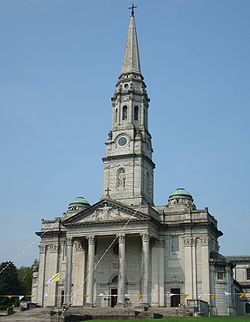Cavan
|
Cavan An Cabhán
|
|
|---|---|
| Town | |

|
|
| Motto: Fortitudine et Prudentia "courage and prudence" |
|
| Location in Ireland | |
| Coordinates: 53°59′28″N 7°21′36″W / 53.9910°N 7.3601°WCoordinates: 53°59′28″N 7°21′36″W / 53.9910°N 7.3601°W | |
| Country | Ireland |
| Province | Ulster |
| County | County Cavan |
| Elevation | 113 m (371 ft) |
| Population (2011) | |
| • Urban | 3,607 |
| • Rural | 7,160 |
| Irish Grid Reference | H419041 |
| Website | www |
Cavan (/ˈkævən/; Irish: an Cabhán, meaning "the hollow") is the county town of County Cavan in Ireland. The town lies in Ulster, near the border with Northern Ireland. The town is on the main N3 road that links Dublin (to the south) with Enniskillen, Ballyshannon and Donegal Town (to the north).
Cavan was founded by the King of East Breifne, Giolla Íosa Ruadh O’Reilly, sometime during his lordship between 1300 and his death in 1330. During his lordship, a Franciscan friary was established close to the O’Reilly stronghold at Tullymongan and was at the centre of the settlement close to a crossing over the river and to the town’s marketplace. The friary’s location is marked by an eighteenth-century tower in the graveyard at Abbey Street which appears to incorporate remains of the original medieval friary tower. The imprint of the medieval town can be followed in the area of Abbey Street, Bridge Street and Main Street (townlands of Tullymongan Upper and Lower).
The O'Reillys later built a new castle in the late fourteenth century on Tullymongan Hill, overlooking the town centre. In the 15th century, the local ruler, Bearded Owen O'Reilly, expanded the town marketplace which attracted merchants from Dublin and Drogheda. The phrase "life of Reilly" is believed to derive from the great wealth and power of the O'Reilly clans, some of which came from their market. They also allowed counterfeit English and Scottish coins to be minted in their territory at this time.King James I granted the town a charter in 1610. This also entitled Cavan town to send two members to the Irish parliament. In February 1690 it was the site of the Battle of Cavan between Williamite and Jacobite troops, during which much of the town was burned. The Jacobite general William Nugent was killed during the battle. Later, during the 18th century, local administrative influence and power passed to the Maxwell family, descendants of Robert Maxwell, Church of Ireland Bishop of Kilmore (1643–1672), a family who later entered the peerage as Baron Farnham.
...
Wikipedia

